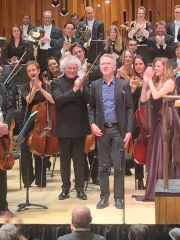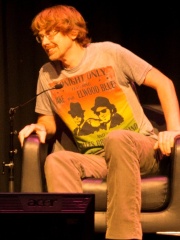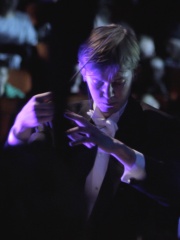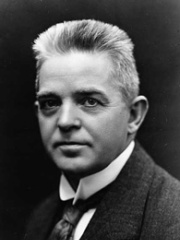
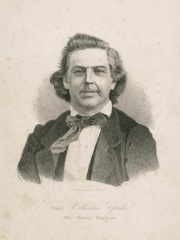
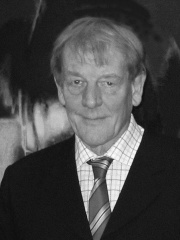


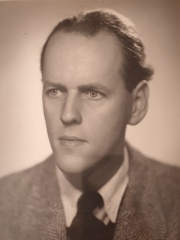
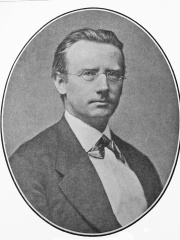
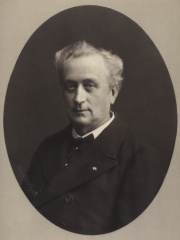
The Most Famous
COMPOSERS from Denmark
Top 10
The following people are considered by Pantheon to be the top 10 most legendary Danish Composers of all time. This list of famous Danish Composers is sorted by HPI (Historical Popularity Index), a metric that aggregates information on a biography's online popularity. Visit the rankings page to view the entire list of Danish Composers.

1. Carl Nielsen (1865 - 1931)
With an HPI of 73.51, Carl Nielsen is the most famous Danish Composer. His biography has been translated into 48 different languages on wikipedia.
Carl August Nielsen (Danish: [ˈkʰɑˀl ˈne̝lsn̩]; 9 June 1865 – 3 October 1931) was a Danish composer, conductor, and violinist, widely recognized as his country's most prominent composer. Brought up by poor yet musically talented parents on the island of Funen, he demonstrated his musical abilities at an early age. He initially played in a military band before attending the Royal Danish Academy of Music in Copenhagen from 1884 until December 1886. He premiered his Op. 1, Suite for Strings, in 1888, at the age of 23. The following year, Nielsen began a 16-year stint as a second violinist in the Royal Danish Orchestra under the conductor Johan Svendsen, during which he played in Verdi's Falstaff and Otello at their Danish premieres. In 1916, he took a post teaching at the Royal Danish Academy and continued to work there until his death. Although his symphonies, concertos and choral music are now internationally acclaimed, Nielsen's career and personal life were marked by many difficulties, often reflected in his music. The works he composed between 1897 and 1904 are sometimes ascribed to his "psychological" period, resulting mainly from a turbulent marriage with the sculptor Anne Marie Brodersen. Nielsen is especially noted for his six symphonies, his Wind Quintet and his concertos for violin, flute and clarinet. In Denmark, his opera Maskarade and many of his songs have become an integral part of the national heritage. His early music was inspired by composers such as Johannes Brahms and Edvard Grieg, but he soon developed his own style, first experimenting with progressive tonality and later diverging even more radically from the standards of composition still common at the time. Nielsen's sixth and final symphony, Sinfonia semplice, was written in 1924–25. He died from a heart attack six years later, and is buried in Vestre Cemetery, Copenhagen. Nielsen maintained the reputation of a musical outsider during his lifetime, both in his own country and internationally. It was only later that his works firmly entered the international repertoire, accelerating in popularity from the 1960s through Leonard Bernstein and others. In Denmark, Nielsen's reputation was sealed in 2006 when four of his works were listed by the Danish Ministry of Culture amongst the greatest pieces of Danish classical music. For many years, he appeared on the Danish hundred-kroner banknote. The Carl Nielsen Museum in Odense documents his life and that of his wife. Between 1994 and 2009 the Royal Danish Library, sponsored by the Danish government, completed the Carl Nielsen Edition, freely available online, containing background information and sheet music for all of Nielsen's works, many of which had not been previously published.

2. Niels Gade (1817 - 1890)
With an HPI of 68.16, Niels Gade is the 2nd most famous Danish Composer. His biography has been translated into 33 different languages.
Niels Wilhelm Gade (22 February 1817 – 21 December 1890) was a Danish composer, conductor, violinist, organist and teacher. Together with Johan Peter Emilius Hartmann, he was the leading Danish musician of his day, in the period known as the Danish Golden Age.

3. Per Nørgård (1932 - 2025)
With an HPI of 63.00, Per Nørgård is the 3rd most famous Danish Composer. His biography has been translated into 26 different languages.
Per Nørgård (pronounced [ˈpʰɛɐ̯ ˈnɶɐ̯ˌkɒˀ]; 13 July 1932 – 28 May 2025) was a Danish composer and music theorist. Though his style varied considerably throughout his career, his music often included repeatedly evolving melodies, in the vein of Jean Sibelius, and a perspicuous focus on lyricism. He based music on "infinity series" and other mathematical models. He composed large-scale works, eight symphonies including the choral Third, concertos and operas such as Gilgamesh. His chamber music includes ten string quartets and music for guitar. Some later works were inspired by the art of Adolf Wölfli. The composer Julian Anderson called Nørgård's style "one of the most personal in contemporary music". Nørgård received several awards, including the 2016 Ernst von Siemens Music Prize.

4. Hans Christian Lumbye (1810 - 1874)
With an HPI of 62.57, Hans Christian Lumbye is the 4th most famous Danish Composer. His biography has been translated into 18 different languages.
Hans Christian Lumbye (Danish pronunciation: [lɔmˈpyː]; 2 May 1810 – 20 March 1874) was a Danish composer of waltzes, polkas, mazurkas and galops, among other things.
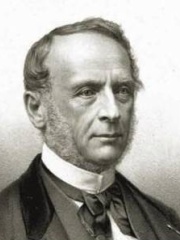
5. Johan Peter Emilius Hartmann (1805 - 1900)
With an HPI of 61.20, Johan Peter Emilius Hartmann is the 5th most famous Danish Composer. His biography has been translated into 19 different languages.
Johan Peter Emilius Hartmann (14 May 1805 – 10 March 1900) was, together with his son-in-law Niels W. Gade, the leading Danish composer of the 19th century, a period known as the Danish Golden Age. According to Alfred Einstein, he was "the real founder of the Romantic movement in Denmark and even in all Scandinavia". J.P.E. Hartmann was the third generation of composers in the Danish musical Hartmann family.

6. Rued Langgaard (1893 - 1952)
With an HPI of 60.40, Rued Langgaard is the 6th most famous Danish Composer. His biography has been translated into 21 different languages.
Rued Langgaard (Danish: [ˈʁuðˀ ˈlɑŋˌkɒˀ]; born Rud Immanuel Langgaard; 28 July 1893 – 10 July 1952) was a late-Romantic Danish composer and organist. His then-unconventional music was at odds with that of his Danish contemporaries but was recognized 16 years after his death.

7. Vagn Holmboe (1909 - 1996)
With an HPI of 58.09, Vagn Holmboe is the 7th most famous Danish Composer. His biography has been translated into 18 different languages.
Vagn Gylding Holmboe (Danish pronunciation: [ˈvɑwˀn ˈhʌlmˌpoˀ]; 20 December 1909 – 1 September 1996) was a Danish composer and teacher.

8. Peter Arnold Heise (1830 - 1879)
With an HPI of 55.81, Peter Arnold Heise is the 8th most famous Danish Composer. His biography has been translated into 15 different languages.
Peter Heise (11 February 1830 – 12 September 1879) was a Danish composer, best known for the opera Drot og Marsk (King and Marshal). Heise's parents tried to press him into becoming a lawyer, but he scored highly in music at school, so he changed direction. He began writing songs at the age of 19. As a young man he collected several hundred folk songs directly from ordinary people. He used these tunes in Tornerose (Sleeping Beauty) and Bergliot (A Danish historical romance). He studied under Niels Wilhelm Gade, who was a major influence on his style. From 1857 to 1865 he was a teacher and organist at Sorø Academy. He did a setting of Hans Christian Andersen's poem Jylland mellem tvende Have (Jutland between two seas) in 1860. The opera Drot og Marsk tells the story of the murder of a medieval king, and contains some folk ballads. It shows a Wagnerian influence. His setting of the Shakespeare song When I was and a little tiny boy and Five Erotic songs are also in print. Many of his songs, usually for soprano and piano, concern dreams, folk-tales and the Middle Ages. Although his instrumental works are almost uniformly excellent, because of the tremendous popularity of his songs, they were overlooked. Among his chamber music works are 6 string quartets, a piano trio, a piano quintet, and a number of instrumental sonatas. His Piano Quintet in F Major, composed in 1869, was widely regarded as a major work. Unfortunately, the work remained in manuscript for 140 years. However, in 2009, the world premiere edition of the parts to the Quintet was published by Edition Silvertrust. They have also reprinted his Cello Sonata (1867) and his Two Fantasy Pieces for Cello and Piano.

9. Emil Hartmann (1836 - 1898)
With an HPI of 54.83, Emil Hartmann is the 9th most famous Danish Composer. His biography has been translated into 15 different languages.
Emil Hartmann (1 February 1836–18 July 1898) was a Danish composer of the romantic period, fourth generation of composers in the Danish Hartmann musical family. His music is distinctly Nordic and tuneful and won great popularity in his time.
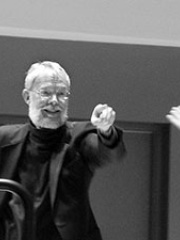
10. Poul Ruders (b. 1949)
With an HPI of 52.33, Poul Ruders is the 10th most famous Danish Composer. His biography has been translated into 16 different languages.
Poul Ruders (born 27 March 1949) is a Danish composer.
People
Pantheon has 13 people classified as Danish composers born between 1805 and 1977. Of these 13, 4 (30.77%) of them are still alive today. The most famous living Danish composers include Poul Ruders, Hans Abrahamsen, and Jesper Kyd. The most famous deceased Danish composers include Carl Nielsen, Niels Gade, and Per Nørgård.
Living Danish Composers
Go to all RankingsPoul Ruders
1949 - Present
HPI: 52.33
Hans Abrahamsen
1952 - Present
HPI: 50.71
Jesper Kyd
1972 - Present
HPI: 49.41
Frederik Magle
1977 - Present
HPI: 45.69
Deceased Danish Composers
Go to all RankingsCarl Nielsen
1865 - 1931
HPI: 73.51
Niels Gade
1817 - 1890
HPI: 68.16
Per Nørgård
1932 - 2025
HPI: 63.00
Hans Christian Lumbye
1810 - 1874
HPI: 62.57
Johan Peter Emilius Hartmann
1805 - 1900
HPI: 61.20
Rued Langgaard
1893 - 1952
HPI: 60.40
Vagn Holmboe
1909 - 1996
HPI: 58.09
Peter Arnold Heise
1830 - 1879
HPI: 55.81
Emil Hartmann
1836 - 1898
HPI: 54.83
Overlapping Lives
Which Composers were alive at the same time? This visualization shows the lifespans of the 9 most globally memorable Composers since 1700.

